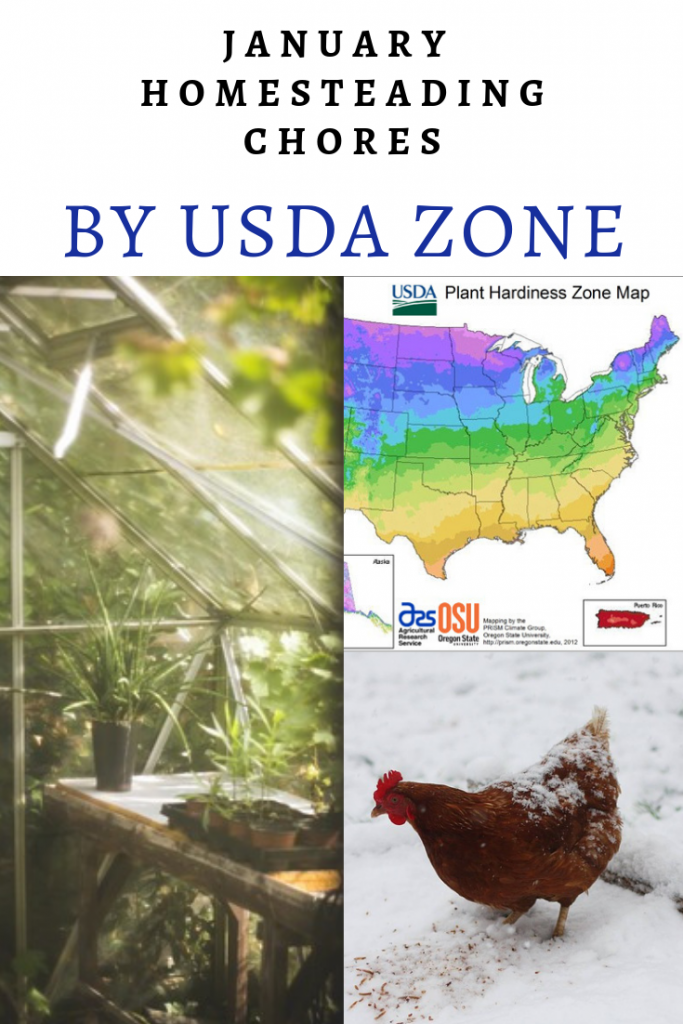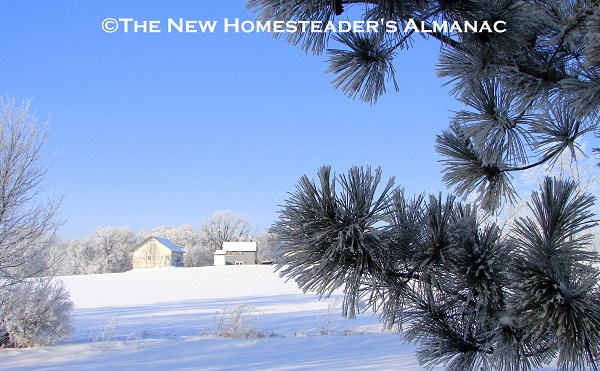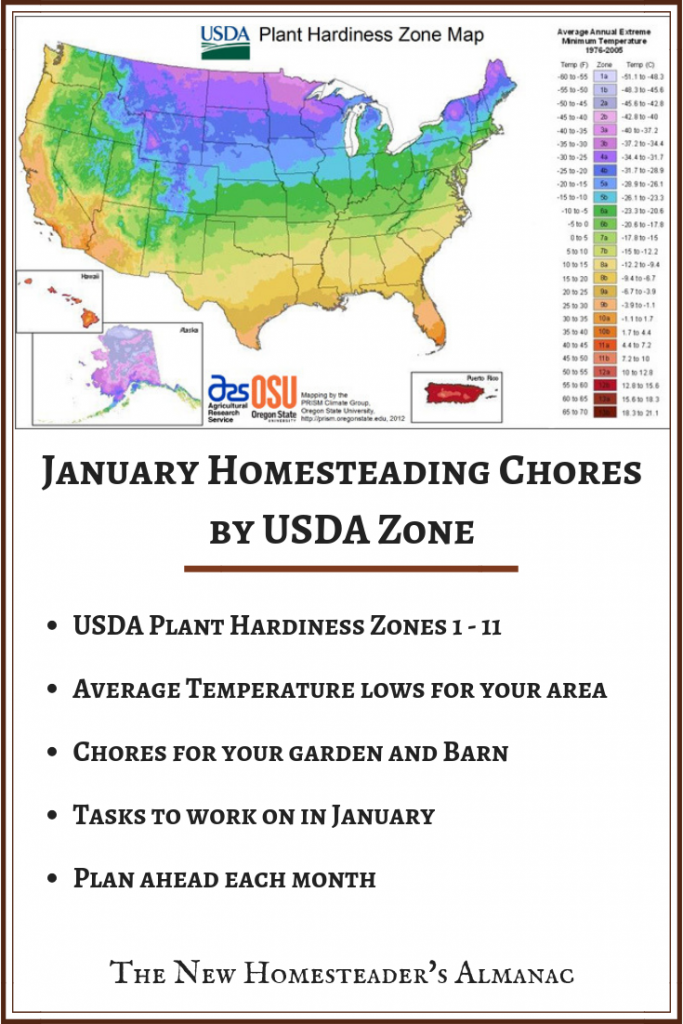
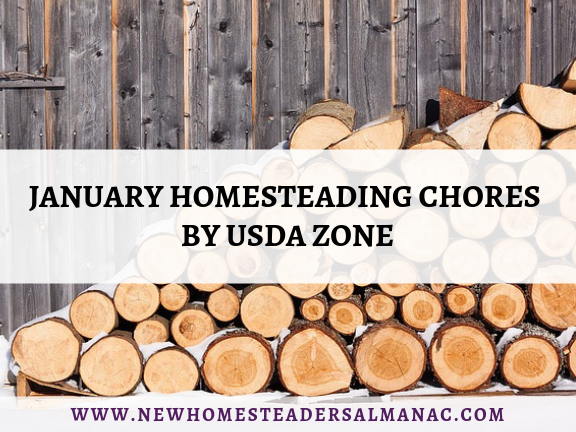
January Homesteading Chores
These homesteading chores are intended as a general guideline. Most homesteaders will need to adjust their activities according to their local climate and conditions. For information tailored to your area, consult your local extension office.
Find Your Zone… Click on the link to see your average first and last frost dates.
USDA Zone 1
Average low temperatures:
- -60 to -55F in zone 1a
- -55 to -50F in zone 1b
Barn Chores
- Keep livestock well fed and protected from wind and cold
- Check for signs of hypothermia and frostbite on livestock
- Water should be kept ice-free with proper heaters
- Make sure barn is ventilated (but draft free) to prevent disease
- Give poultry corn or sunflower seed for extra calories
- Poultry may lay eggs with 14 hours of artificial light a day in their coop
- Gather eggs often to prevent freezing
- Keep bedding clean and dry
Garden Chores
- Order gardening catalogs
- Plan garden beds (be sure to rotate crops)
- Clean and oil tools if you didn’t do so in autumn
- Grow herbs and houseplants under lights indoors
- Check houseplants for scale and mites, treat if necessary
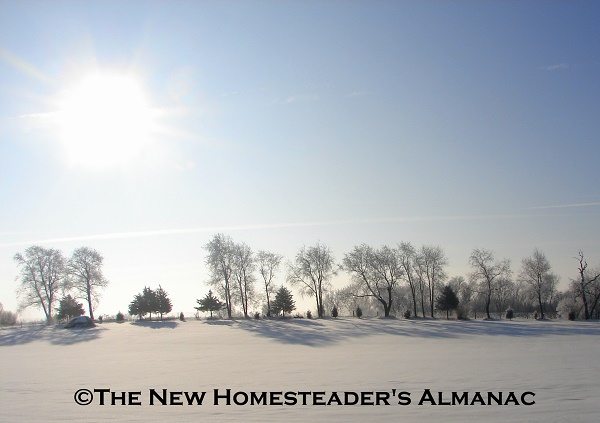
USDA Zone 2
Average Low Temperatures:
- -50 to -45F in zone 2a
- -45 to -30F in zone 2b
Barn Chores
- Keep livestock well fed and protected from wind and cold
- Check for signs of hypothermia and frostbite on livestock
- Water should be kept ice-free with proper heaters
- Make sure barn is ventilated (but draft free) to prevent disease
- Give poultry corn or sunflower seed for extra calories
- Poultry may lay eggs with 14 hours of artificial light a day in their coop
- Gather eggs often to prevent freezing
- Keep bedding clean and dry
Garden Chores
- Order gardening catalogs
- Plan garden beds (be sure to rotate crops)
- List seed varieties to order
- Check fruit-bearing trees and shrubs for damage from wildlife
- Clean and oil tools if you didn’t do so in autumn
- Grow herbs and houseplants under lights indoors
- Check houseplants for scale and mites, treat if necessary
- Houseplants do not need fertilizer until daylight hours increase
USDA Zone 3
Average Low Temperatures:
- -40 to -35F in zone 3a
- -35 to -30F in zone 3b
Barn Chores
- Keep livestock well fed and protected from wind and cold
- Check for signs of hypothermia and frostbite on livestock
- Water should be kept ice-free with proper heaters
- Make sure barn is ventilated (but draft free) to prevent disease
- Give poultry corn or sunflower seed in the evening to keep them warm
- Poultry may lay eggs with 14 hours of artificial light a day in their coop
- Gather eggs often to prevent freezing
- Keep bedding clean and dry
- Check fence lines for needed repairs and signs of predators
Garden Chores
- Get seed orders ready
- Plan garden beds (be sure to rotate crops)
- Clean up seed starting area and list supplies needed
- Check fruit-bearing trees and shrubs for damage from wildlife
- Clean and oil tools if you didn’t do so in autumn
- Grow herbs and houseplants under lights indoors
- Check houseplants for scale and mites, treat if necessary
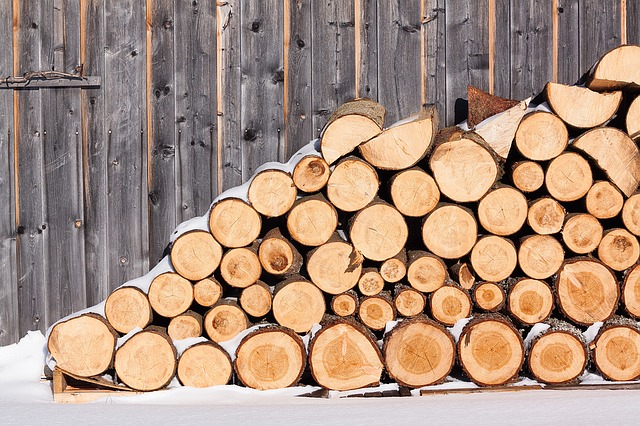
USDA Zone 4
Average Low Temperatures:
- -30 to -25F in zone 4a
- -25 to -20F in zone 4b
Barn Chores
- Keep livestock well fed and protected from wind and cold
- Check for signs of hypothermia and frostbite on livestock
- Water should be kept ice-free with proper heaters
- Make sure barn is ventilated (but draft free) to prevent disease
- Give poultry corn or sunflower seed in the evening to keep them warm
- Poultry may lay eggs with 14 hours of artificial light a day in their coop
- Gather eggs often to prevent freezing
- Keep bedding clean and dry
- Check fence lines for needed repairs and signs of predators
- Check sugaring equipment for needed repairs, stock up on firewood for boiling sap
Garden Chores
- Order gardening seeds and supplies
- Clean seed starting area and order supplies needed
- Plan garden beds (be sure to rotate crops)
- List fruit trees, shrubs, perennials, and annual plants to order
- Check fruit-bearing trees and shrubs for damage from wildlife
- Clean and sharpen pruning tools
- Clean and oil tools if you didn’t do so in autumn
- Grow herbs and houseplants in sunny windows or under lights
- Check houseplants for scale and mites, treat if necessary
USDA Zone 5
Average Low Temperatures:
- -20 to -15F in zone 5a
- -15 to -10F in zone 5b
Barn Chores
- Keep livestock well fed and protected from wind and cold
- Check for signs of frostbite on chicken combs, wattles, and feet
- Water should be kept ice-free with proper heaters
- Make sure barn is ventilated (but draft free) to prevent disease
- Give poultry corn or sunflower seed in the evening to keep them warm
- Poultry may lay eggs with 14 hours of artificial light a day in their coop
- Gather eggs often to prevent freezing
- Keep bedding clean and dry
- Order hatchery catalogs for spring poultry purchases
- Check fence lines for needed repairs and signs of predators
- Check sugaring equipment for needed repairs, stock up on firewood for boiling sap
Garden Chores
- Order gardening seeds and supplies from seed catalogs
- Set up seed starting area
- Plant seeds of cool-season crops and spring flowering annuals indoors
- Plant seeds of cold-tolerant perennials indoors
- Plan garden beds (be sure to rotate crops)
- List fruit trees, shrubs, perennials, and annual plants to order
- Check fruit-bearing trees and shrubs for damage from wildlife
- Clean and sharpen pruning tools
- Begin pruning fruit trees if conditions allow
- Grow herbs and houseplants in sunny windows or under lights
- Check houseplants for scale and mites, treat if necessary

USDA Zone 6
Average Low Temperatures:
- -10 to -5F in zone 6a
- -55 to 0F in zone 6b
Barn Chores
- Protect livestock from wind and cold
- Check for signs of frostbite on chicken combs, wattles, and feet
- Water should be kept ice-free with proper heaters
- Make sure barn is ventilated (but draft free) to prevent disease
- Give poultry corn or sunflower seed in the evening to keep them warm
- Poultry may lay eggs with 14 hours of artificial light a day in their coop
- Gather eggs often to prevent freezing
- Keep bedding clean and dry
- Plan hatchery orders for day old poultry
- Clean and organize hatching supplies and brooders
- Prepare for livestock birthing, clean and check bottles and first aid kit
- Check fence lines for needed repairs and signs of predators
- Clean sugaring equipment, stock up on firewood for boiling sap
- Collect and boil sap on warm days
Garden Chores
- Order gardening seeds and supplies from seed catalogs
- Set up seed starting area and purchase potting mix & materials
- Plant seeds of cool-season crops and spring flowering annuals indoors
- Plant perennial seeds indoors
- Plant cool season vegetables indoors
- Plant seeds of slow growing, warm season vegetables indoors
- Plan garden beds (be sure to rotate crops)
- Order fruit trees, shrubs, perennials, and annual plants for spring
- Prune fruit trees and shrubs
- Clean and sharpen gardening tools
- Grow herbs and houseplants in sunny windows
- Increase fertilizer for houseplants slightly

USDA Zone 7
Average Low Temperatures:
- 0 to 5F in zone 7a
- 5 to 10F in zone 7b
Barn Chores
- Make sure barn is ventilated (but draft free) to prevent disease
- Give poultry corn or sunflower seed in the evening to keep them warm
- Poultry may lay eggs with 14 hours of artificial light a day in their coop
- Gather eggs often in freezing temperatures
- Keep bedding clean and dry
- Place orders for day old poultry in advance to guarantee timely delivery
- Clean and organize hatching supplies and brooders
- Prepare for livestock birthing, clean and check bottles and first aid kit
- Check your fencing for needed repairs and signs of predators
- Prepare equipment for planting spring crops
Garden Chores
- Finish ordering gardening seeds and supplies
- Finish setting up seed starting area
- Plant seeds of warm-season annual flowers and vegetables
- Direct seed cool-season crops in cold frames or low tunnels
- Prepare garden beds
- Plant dormant fruit trees, shrubs, and perennials
- Apply dormant oil spray to fruit trees
- Clean and sharpen gardening tools
- Grow herbs and houseplants in sunny windows
- Increase fertilizer for houseplants slightly

USDA Zone 8
Average Low Temperatures:
- 10 to 15F in zone 8a
- 15 to 20F in zone 8b
Barn Chores
- Pasture livestock in good weather
- Make sure barn is ventilated (but draft free) to prevent disease
- Give poultry corn or sunflower seed if weather is cold
- Poultry may lay eggs with 14 hours of artificial light a day in their coop
- Gather eggs often during freezing temperatures
- Keep bedding clean and dry
- Place orders for day old poultry
- Clean and organize hatching supplies and brooders
- Prepare for livestock birthing, clean and check bottles and first aid kit
- Repair fencing and check for signs of predators
Garden Chores
- Prepare garden beds
- Harvest cool-season greens, such as spinach and kale, from protected beds
- Direct seed cool season vegetables
- Plant seeds of warm-season flowers and vegetables indoors under lights
- Plant dormant fruit trees, shrubs, hardy perennials, and bare root roses
- Plant evergreens
- Prune winter blooming trees and shrubs after flowering
- Spray dormant oil on fruit trees before buds swell
- Clean and sharpen gardening tools
- Grow herbs and houseplants in sunny windows
- Increase fertilizer for houseplants
- Protect tender plants from frost
USDA Zone 9
Average Low Temperatures:
- 20 to 25F in zone 9a
- 25 to 30F in zone 9b
Barn Chores
- Pasture livestock, protect from inclement weather
- Make sure barn is ventilated to prevent disease
- Give poultry corn or sunflower seed in the evening only if weather is cold
- Poultry may lay eggs with 14 hours of light a day
- Gather eggs often if temperatures drop
- Keep bedding clean and dry
- Place orders for day old poultry
- Begin hatching poultry in incubators
- Prepare for livestock birthing, clean and check bottles and first aid kit
- Repair fencing and check for signs of predators
Garden Chores
- Harvest cool season crops
- Direct seed next crop of cool-season vegetables
- Plant warm-season plants under lights indoors
- Plant fruit trees, shrubs, hardy perennials, and frost tolerant annuals
- Plant citrus trees
- Clean and sharpen gardening tools
- Grow herbs and houseplants in sunny windows, move outdoors in nice weather
- Increase fertilizer for houseplants
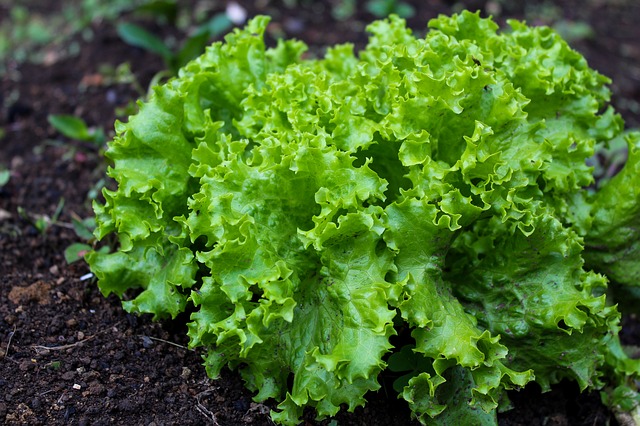
USDA Zone 10
Average Low Temperatures:
- 30 to 35F in zone 10a
- 35 to 40F in zone 10b
Barn Chores
- Pasture livestock
- Make sure barn is ventilated (but draft free) to prevent disease
- Poultry may lay eggs with 14 hours of light a day
- Keep bedding clean and dry
- Prepare brooders for day-old poultry orders
- Hatch eggs in incubators
- Prepare for livestock birthing, clean and check bottles and first aid kit
- Repair fencing and check for signs of predators
Garden Chores
- Harvest cool-season crops grown in cold frames
- Direct seed next crop of cool-season vegetables in cold frames
- Harden off cool-season flower and vegetable seedlings and plant in protected areas
- Plant warm-season plants under lights indoors
- Protect citrus trees from frost
- Plant citrus trees, fruit trees, shrubs, hardy perennials, and frost tolerant annuals
- Clean and sharpen gardening tools
- Grow herbs and houseplants in sunny windows
- Increase fertilizer for houseplants

USDA Zone 11
Average Low Temperatures:
- 40 to 45F for zone 11a
- 45 to 50F for zone 11b
Barn Chores
- Pasture livestock
- Poultry may lay eggs with 14 hours of light a day
- Keep bedding clean and dry to prevent disease
- Place orders for day old poultry
- Hatch poultry in incubators
- Prepare for livestock birthing, clean and check bottles and first aid kit
- Repair fencing and check for signs of predators
Garden Chores
- Harvest cool-season crops
- Direct seed next crop of cool-season vegetables
- Harden off seedlings of cool-season annuals
- Set out cold tolerant perennials
- Plant heat-loving plants under lights indoors
- Plant citrus, fruit trees, shrubs, and hardy perennials
- Weed beds
- Grow herbs and houseplants in sunny windows or on patios
- Fertilize houseplants
- Harvest citrus fruits
Notes: Within each USDA Zone, there are many different micro-climates and variations in frost free dates, average low temperatures, and average high temperatures. Visit the Interactive USDA Zone Map for the most accurate information about your local conditions.
The information listed here is intended to give a general guideline to appropriate homesteading activities for your area. Each individual using these guidelines must determine if the information is accurate for their conditions.
As an Amazon affiliate, I earn a commission from qualifying purchases.
